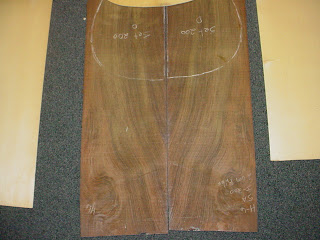OK, I screwed up again...well actually not me, but my router. The locking mechanism slipped slightly causing the bit to rise and take a bigger bite out of the edge I was trying to round over. But finally, third time's a charm and I successfully created the nearly finished bridge for L's guitar. See photos. Finishing touches will likely include a frame around the inlay on the bridge tieblock, which matches the pattern of the rosette as you will notice. This is a BR bridge. I will produce two more in the next few days, now that I have the hang of it. Again, that's the benefit of doing a multi-guitar campaign. I saw Kevin from Indy Craft and he is waiting for some wood filler to arrive before proceeding with the test pieces. I'm sooooo looking forward to seeing these.
Did some re-arranging in the shop today and I'm determined to get the place looking like a professional worked there as it should.
I will start the testing and thinning of tops that I have in stock to see if any of them qualify for C's guitar. I have a couple that I think may prove to be outstanding, which is certainly what this guitar deserves. Next will be the rough-out of the back BR for C's guitar. The two halves will then be jointed and joined. I do the jointing (e.g. preparation of the matching edges that will be glued together to make the book-matched back panel. This is going to be awsome...looking and sounding...is my bet. The jointing process takes place on a "shooting board" which allows the two joining edges to be planed to absolute 0 tolerance matching edges, which when butted together allow no light to penetrate. This a painstaking process employing my best, freshly sharpened block plane. It is possible to sand to two edges, but one of my friends and the guitarmaking community agree that edges planed with an extremely sharp plane iron, can actually result in an invisible, extremely strong glue joint using hot animal hide glue. This is what Dobbin becomes when he goes to horsey heaven. And, like the trees, which make up the instrument, the loss of a living thing becomes a beautiful, almost living instrument capable of producing great joy, and a beautiful and lasting source of sound capable of melting the hardest heart...in the right hands, of course. The right hands are those of anyone who truly loves the guitar and its potential:
Thoughts on that...the guitar, that is: I was in the drug store the other day and looking through the magazine rack. The only magazine that had anything to do with the "guitar" was a magazine entitled "Guitar". It was almost entirely devoted to the electric, solid body instrument played by rockers and rollers and a few jazz and blues, etc. Now, I have nothing against those folks and I admire the skill of a Clapton, BB King or any number of players of this instrument. But I take issue with the terminology defining this instrument as THE guitar. It bears little resemblance to the instruments of Torres, Hauser and Ramirez. First, the sound of a solid body guitar is only possible with a plethora of electronic stuff, which massages a magneto-electric signal created by the vibration of wires (strings?) over a magnetic pickup. This signal is then processed into sounds, which may or may not resemble anything like the sound of a Hauser or Ramirez classical guitar. Somehow, I think that the pure instrument of historical importance, created by Torres, etc. should bear the title "GUITAR". Although derived from the basic idea of the guitar, block o' two-by-four, solid body instruments should bear their own moniker, identifying them as "Guit-planks" or "electro-tars" or some such thing. They need to have their own identity separate from the guitar. Acoustic, steel string guitars, I really take no issue with, because the technology, although it can include electronics, is still really an acoustic box, capable of producing beautiful, albeit somewhat harsher, sounds than the classical guitar. Just saying.
That's all for now,
g'day
Does anybody read this stuff?















